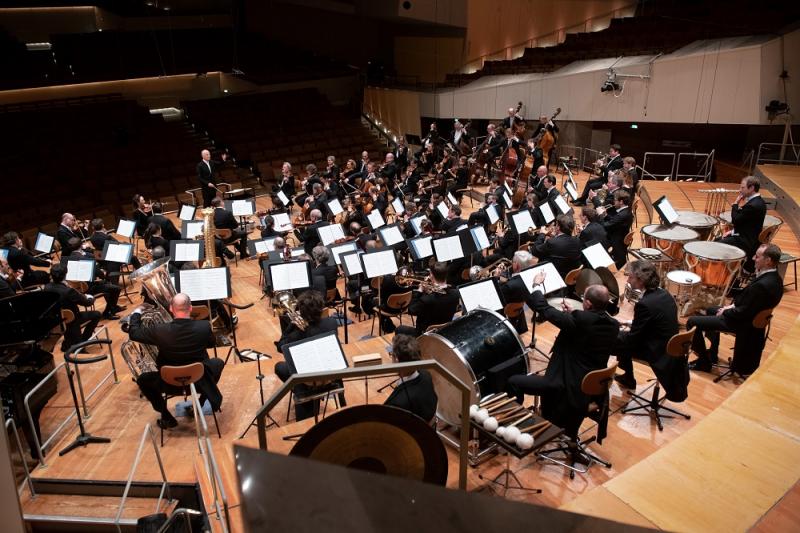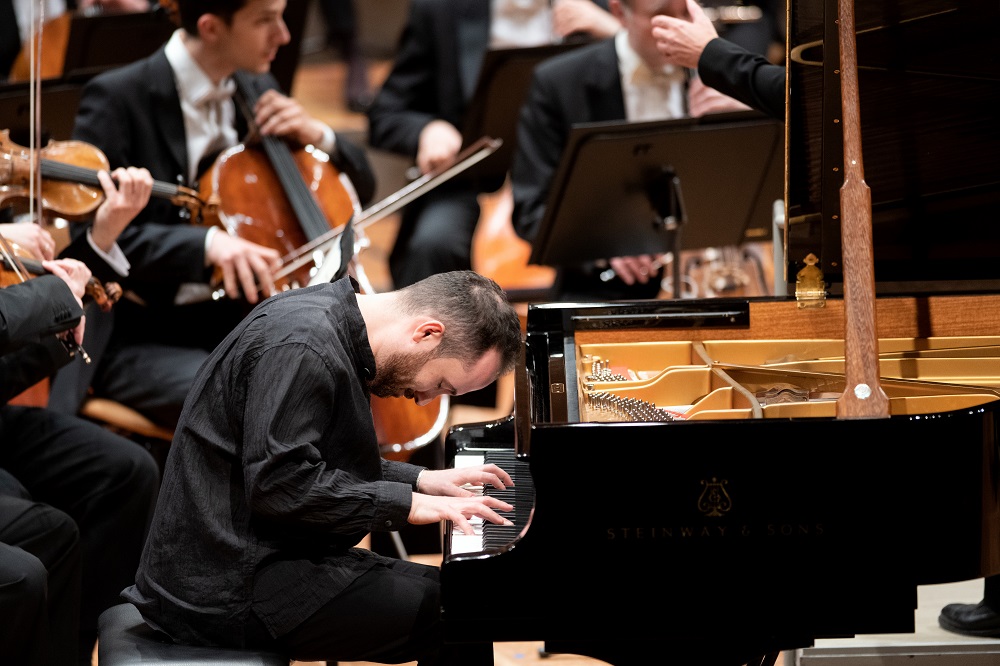Levit, Berlin Philharmoniker, Paavo Järvi, Digital Concert Hall review - optimal light and dark | reviews, news & interviews
Levit, Berlin Philharmoniker, Paavo Järvi, Digital Concert Hall review - optimal light and dark
Levit, Berlin Philharmoniker, Paavo Järvi, Digital Concert Hall review - optimal light and dark
Different energies in buoyant Beethoven and disturbing Prokofiev

It seems right that (arguably) the greatest orchestra in the world has (unarguably) the best livestreaming and archive service.
Bright comes before dark: this is a lithe, joyous Beethoven “Emperor” Concerto, only fitfully grandiose when the passing moment requires (as in the big rhythmic cannonades and octaves of the first-movement development). The orchestra under Järvi is as supple and winged as Levit (pictured below) in his solo passages, and this is that rare thing, a true concerto partnership. The pianist says in the splendid conversation with his conductor before the performance that he can actually take pleasure in what the orchestra’s doing while he ripples away arpeggio wise – the difficulty, he adds, being substantially less than comparable passages in Brahms’s First Concerto. You see it, to cite one of many instances, when the two horns (Stefan Dohr and Sarah Willis) float so artistically. It’s refreshing to have an Adagio which is genuinely un poco mosso. Each music lover will have his or her own idea of how this familiar music should go; some like it slower, but for me, this is the ideal.  What Järvi says, too, about Prokofiev in the interval is borne out by the shifting colours of a dark symphony to equal the monoliths of Shostakovich: always the element of surprise, of taking a turn you didn’t expect (a good pianist colleague of Levit’s, Boris Giltburg, made the same point about the composer’s elusiveness as compared to the more clear-cut progress of Shostakovich in my Russian music Zoom class last Thursday). The energy stops the tragic stretches ever being bogged down in self-pity; the Wagnerian drama of Prokofiev’s most astounding slow movement – it even quotes the “wound” motif from Parsifal, tying in with the composer’s own lost health after the Second World War – shines uncomfortably in that garish doubling of trumpet and first violins, but scales down to mellow, love-lorn horns and the toybox twinkle of harp and celesta.
What Järvi says, too, about Prokofiev in the interval is borne out by the shifting colours of a dark symphony to equal the monoliths of Shostakovich: always the element of surprise, of taking a turn you didn’t expect (a good pianist colleague of Levit’s, Boris Giltburg, made the same point about the composer’s elusiveness as compared to the more clear-cut progress of Shostakovich in my Russian music Zoom class last Thursday). The energy stops the tragic stretches ever being bogged down in self-pity; the Wagnerian drama of Prokofiev’s most astounding slow movement – it even quotes the “wound” motif from Parsifal, tying in with the composer’s own lost health after the Second World War – shines uncomfortably in that garish doubling of trumpet and first violins, but scales down to mellow, love-lorn horns and the toybox twinkle of harp and celesta.
The finale’s at first subtle underminings of a jolly pioneer galop accumulate with frightening speed towards the overpowering denouement. This is a work that ends on a chord of E flat major, but it’s the most devastating, surely, in any symphony. What a privilege to feel oneself back in the realm of the large-scale 20th century symphonic masterpieces again, though nothing will ever be as good as being there.
- Having gone out live, this performance is currently being edited for the permanent Digital Concert Hall archive (£)
- More classical music reviews from theartsdesk
rating
Share this article
The future of Arts Journalism
You can stop theartsdesk.com closing!
We urgently need financing to survive. Our fundraising drive has thus far raised £49,000 but we need to reach £100,000 or we will be forced to close. Please contribute here: https://gofund.me/c3f6033d
And if you can forward this information to anyone who might assist, we’d be grateful.

Subscribe to theartsdesk.com
Thank you for continuing to read our work on theartsdesk.com. For unlimited access to every article in its entirety, including our archive of more than 15,000 pieces, we're asking for £5 per month or £40 per year. We feel it's a very good deal, and hope you do too.
To take a subscription now simply click here.
And if you're looking for that extra gift for a friend or family member, why not treat them to a theartsdesk.com gift subscription?
more Classical music
 Kempf, Brno Philharmonic, Davies, Bridgewater Hall, Manchester review - European tradition meets American jazz
Bouncing Czechs enjoy their Gershwin and Brubeck alongside Janáček and Dvořák
Kempf, Brno Philharmonic, Davies, Bridgewater Hall, Manchester review - European tradition meets American jazz
Bouncing Czechs enjoy their Gershwin and Brubeck alongside Janáček and Dvořák
 Solomon, OAE, Butt, QEH review - daft Biblical whitewashing with great choruses
Even a top soprano and mezzo can’t make this Handel paean wholly convincing
Solomon, OAE, Butt, QEH review - daft Biblical whitewashing with great choruses
Even a top soprano and mezzo can’t make this Handel paean wholly convincing
 Two-Piano Gala, Kings Place review - shining constellations
London Piano Festival curators and illustrious friends entertain and enlighten
Two-Piano Gala, Kings Place review - shining constellations
London Piano Festival curators and illustrious friends entertain and enlighten
 Echo Vocal Ensemble, Latto, Union Chapel review - eclectic choral programme garlanded with dance
Beautiful singing at the heart of an imaginative and stylistically varied concert
Echo Vocal Ensemble, Latto, Union Chapel review - eclectic choral programme garlanded with dance
Beautiful singing at the heart of an imaginative and stylistically varied concert
 Scott, Irish Baroque Orchestra, Whelan, RIAM, Dublin review - towards a Mozart masterpiece
Characteristic joy and enlightenment from this team, but a valveless horn brings problems
Scott, Irish Baroque Orchestra, Whelan, RIAM, Dublin review - towards a Mozart masterpiece
Characteristic joy and enlightenment from this team, but a valveless horn brings problems
 Classical CDs: Voice flutes, flugelhorns and froth
Baroque sonatas, English orchestral music and an emotionally-charged vocal recital
Classical CDs: Voice flutes, flugelhorns and froth
Baroque sonatas, English orchestral music and an emotionally-charged vocal recital
 Kanneh-Mason, Britten Sinfonia, Shave, Milton Court - a grin and a big beaming smile
A pair of striking contemporary pieces alongside two old favourites
Kanneh-Mason, Britten Sinfonia, Shave, Milton Court - a grin and a big beaming smile
A pair of striking contemporary pieces alongside two old favourites
 theartsdesk at the New Ross Piano Festival - Finghin Collins’ musical rainbow
From revelatory Bach played with astounding maturity by a 22 year old to four-hand jazz
theartsdesk at the New Ross Piano Festival - Finghin Collins’ musical rainbow
From revelatory Bach played with astounding maturity by a 22 year old to four-hand jazz
 First Person: Manchester Camerata's Head of Artistic Planning Clara Marshall Cawley on questioning the status quo
Five days of free events with all sorts of audiences around Manchester starts tomorrow
First Person: Manchester Camerata's Head of Artistic Planning Clara Marshall Cawley on questioning the status quo
Five days of free events with all sorts of audiences around Manchester starts tomorrow
 Goldscheider, Brother Tree Sound, Kings Place review - music of hope from a young composer
Unusual combination of horn, strings and electronics makes for some intriguing listening
Goldscheider, Brother Tree Sound, Kings Place review - music of hope from a young composer
Unusual combination of horn, strings and electronics makes for some intriguing listening

Add comment